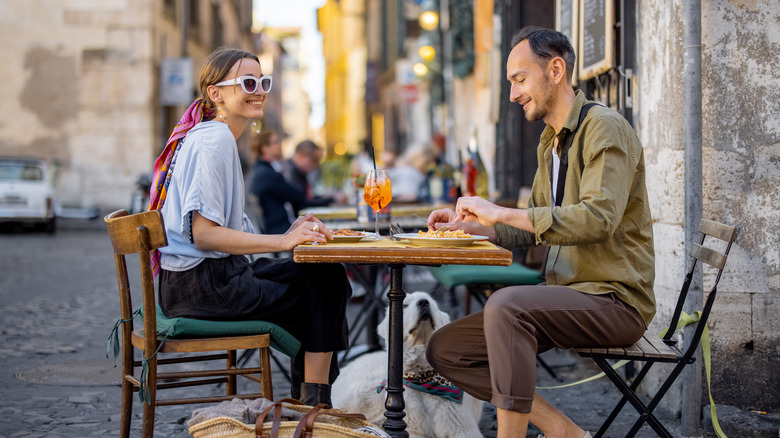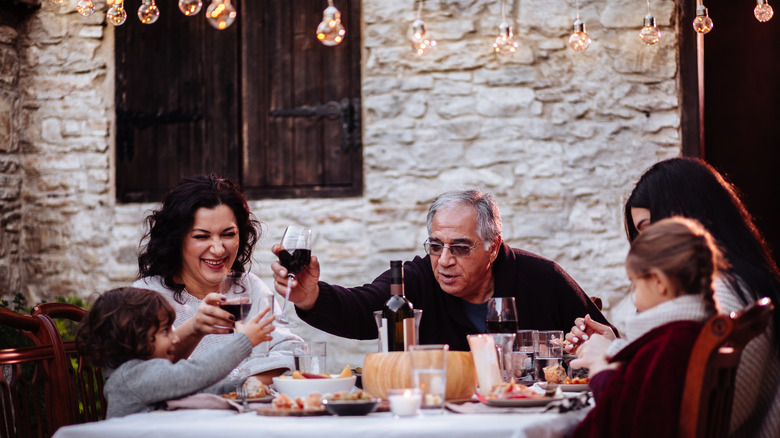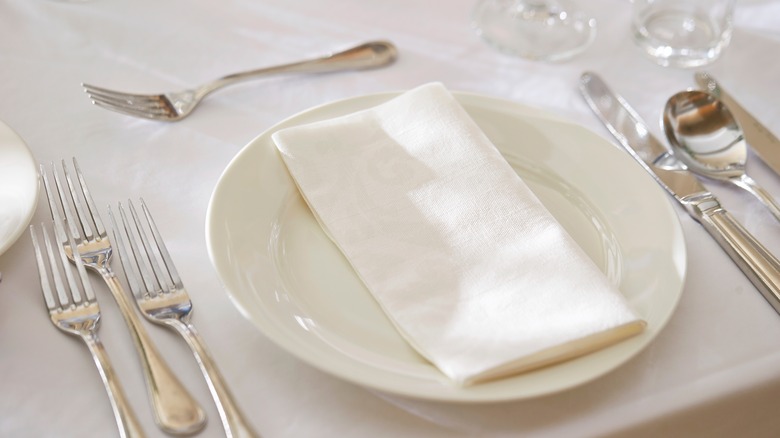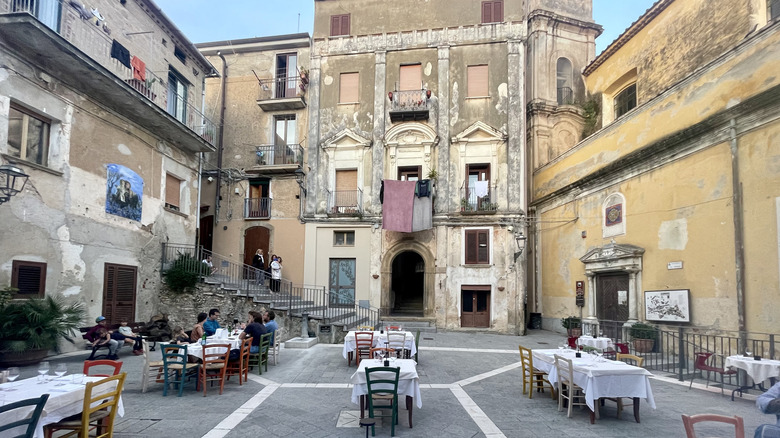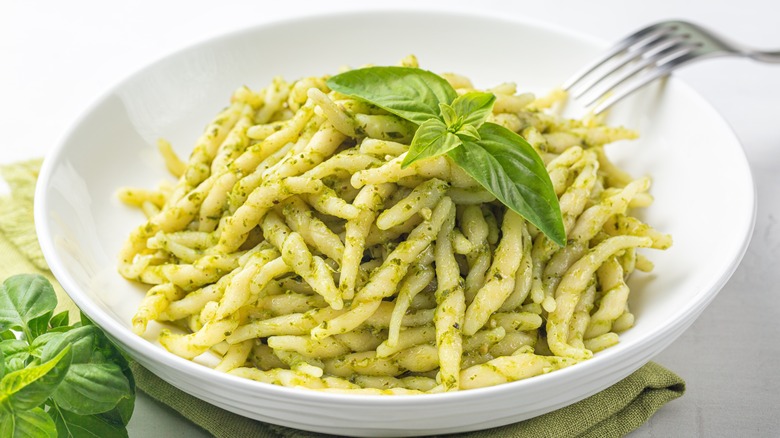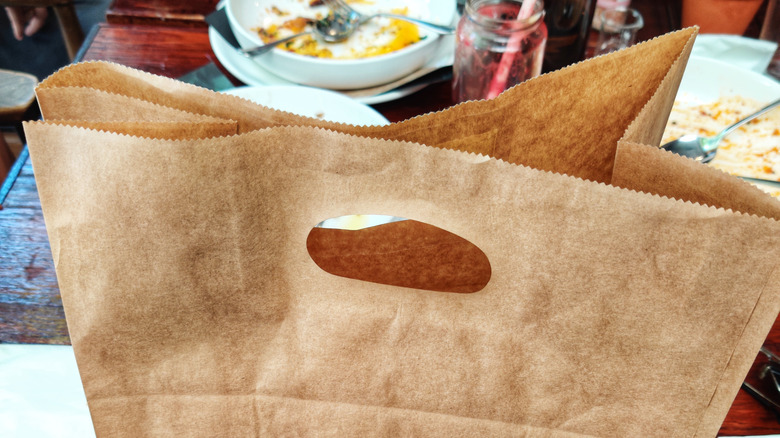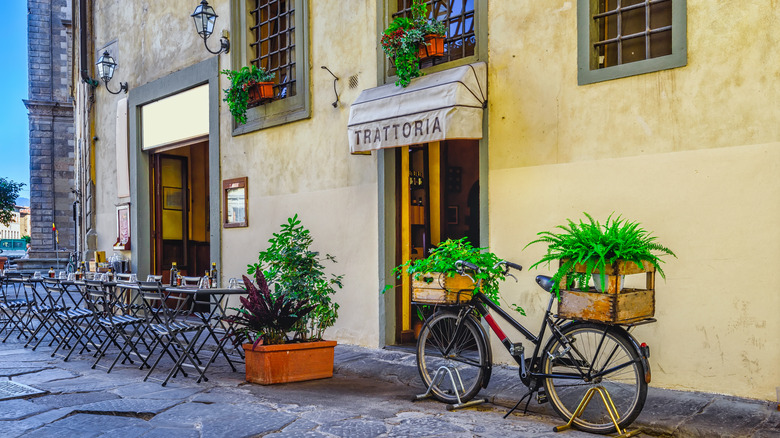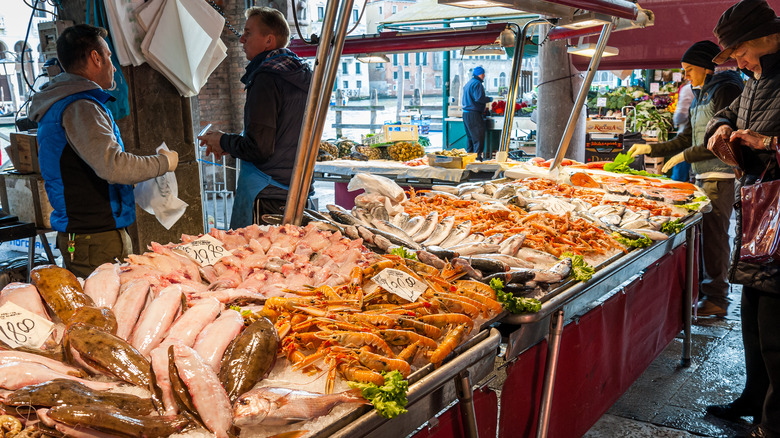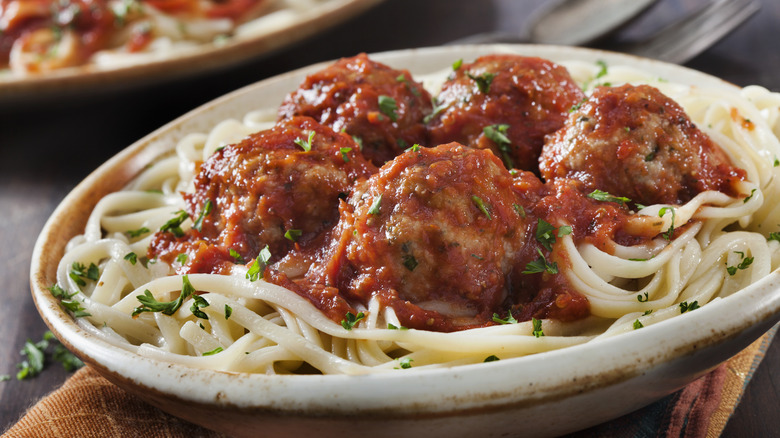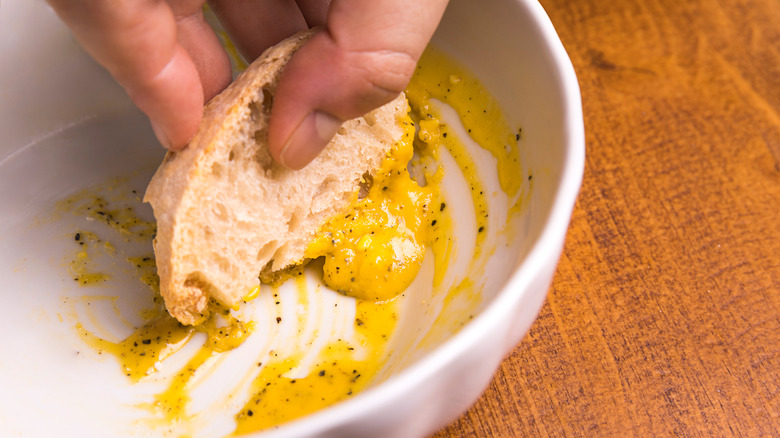14 Tips For Eating Like A Local In Italy
Most foodies daydream about eating their favorite cuisine in its homeland. While some might imagine slurping down heaping bowls of ramen, others see themselves twirling strands of spaghetti from a plate piled high. If Italian food makes your mouth water, there's nothing more exciting than the idea of savoring a meal on the other side of the Atlantic. Although the U.S. is over 30 times larger than the European nation, Italy's culinary diversity should not be underestimated.
Among the variety you'll find from North to South, one element remains consistent: Italians are passionate about food. Food is steeped in tradition, and numerous customs and habits dictate how certain dishes and meals are enjoyed locally. If you're visiting Italy and want to enjoy an authentic experience, you'll want to skip restaurants solely targeted to tourists. And when you do, you're sure to find yourself having to adapt to some aspects that might seem curious as an outsider. Here are our top tips for eating like a local in Italy.
Avoid being rushed for a meal
While your idea of a sit-down meal might involve shoveling food into your mouth while you swipe through your phone, in Italy, the experience is more leisurely. Various dishes make up multiple courses, culminating in a drawn-out event that highlights the flavors on the plate. Instead of using the time purely to consume and savor food, Italians typically treat meals as an occasion to spend time with family and friends.
Anthropologists have studied the role of food in Italian culture, finding it to be linked to pleasure (via Tuscookany). And what better way to experience such a positive feeling than with people you care about? While daily meals in good company are ideal, Sunday lunch in Italy brings the full expression to life. Although eating lunch on the go has become more prevalent in the last years to satisfy changes in daily work schedules, the traditional philosophy is to slow down. True to that point, in 1986, Slow Food was born in Italy, leading to an international movement that highlights local gastronomic specialties and the joys of sharing them in a relaxed atmosphere.
If you're grabbing a sandwich at a corner bakery, there's no need to linger at the counter. It's fair to want to maximize your time discovering a city. However, when you make a point to take a seat at a restaurant, give yourself enough time to savor the experience without checking your watch every few minutes.
Understand the coffee etiquette
Sure, you could ignore the local coffee culture and order a cappuccino with lunch, but set your habits aside to blend in. For starters, seek out a bar, which is the place to get your morning coffee in Italy. Coffee shops, aka caffès, offer a more elaborate setting where you could wile away the time, but for a simple coffee, head to the bar and place your order at the till. Once you pay, you'll receive a receipt to hand off to the barista. You'll have the option of drinking your coffee at the counter or seated — and you'll most likely be asked your preference by the cashier since the latter boosts the price.
Don't expect fancy drinks with countless add-ins. The most basic is an espresso, which is a standard caffè. It will probably be smaller than what you're used to, so order a caffè lungo or americano if you want extra water. For more caffeine get a doppio (or a double), and if you want a splash of milk get a macchiato. Unless you want a glass of milk, ask for a caffè latte or a latte macchiato, and skip the milk-heavy drinks past mid-morning. After a meal, opt for a simple caffè, or if the day calls for imbibing, order a caffè corretto, usually enhanced with a splash of grappa. Forget about getting your coffee to go; just savor the brief pause from your hectic day.
Don't expect everything on the table to be included
If your favorite part of going to your local Italian restaurant is scarfing down baskets of free breadsticks, you'll want to switch it up when you're actually in Italy. Most traditional restaurants charge extra for bread, which may or may not be included in the coperto, or cover fee.
Unlike the U.S. where diners can safely assume their table setting is included with the cost of their meal, Italian establishments add a separate charge per customer. It's typically just a few euros, but some locations can take advantage of unsuspecting clients and charge a premium. The cost must be indicated on the menu, so look out for the fine print.
As for water, don't expect your glass to be automatically filled with free water the moment you sit down. It's far more common for Italians to order bottled sparkling or still water. If you insist on drinking tap water, you'll have to be extra clear with the waiter — they probably won't rush around to refill it regularly either.
Adapt to local dining hours
It's natural to take on some of the local customs while traveling and adapting to the eating schedules will save you a lot of trouble. If you have lunch before noon and dinner at 6 p.m. at home, you'll need to stretch out the hours unless you only want to dine at restaurants that solely cater to tourists.
Lunch is easier to adjust to, especially if you are just grabbing a sandwich on the go. However, if you want to sit down for a longer meal, pushing the start to 12:30 or 1 p.m. should yield more options. In fact, it's common for stores to close around 1 p.m. and open up again sometime around 3 p.m. or 4 p.m., giving employees the chance to go home for a warm meal.
Typically, nothing dinner-like is happening before 7 p.m., and that's still pushing it as many people dine around 8 p.m. or 9 p.m. Due to seasonal variations in temperature and the influence of surrounding countries, people tend to dine a bit earlier in the North than in the hot South. Of course, that doesn't mean there's no food to be had earlier. Prior to dinner, Italians mark the transition from the workday to the evening during aperitivo, with a drink and some light snacks from about 6 p.m. to 8 p.m.
Eat the regional specialties
When dining at an Italian restaurant in the U.S., it can be easy to forget the vast diversity of Italy's food. Although certain dish categories are popular across the country, local variations highlight the nuances from one place to the next. If you're perusing a restaurant menu in Italy and find all the same dishes you'd find at its American counterpart, you've likely stepped into a tourist trap. Traditional restaurants will serve regional dishes featuring seasonal ingredients.
Take pasta, the epitome of Italian food in many people's minds, and a dish with more variations than you could consume in a lifetime. Not only do the accompanying ingredients change, but you're likely to find different pasta shapes to pair with them from north to south. Trofie al pesto showcases Liguria's fresh basil, spaghetti alle vongole places clams and seafood front and center, and puttanesca from Naples promises a salty kick. Tagliatelle alla Bolognese reflects its origins in Bologna, while Rome brings us cacio e pepe and carbonara. Skip the familiar and opt for something distinctly regional for a truly gustatory experience. And of course, it doesn't have to include pasta for it to be an authentic Italian meal.
Learn the menu categories
If you're used to reading English menus in the U.S., it'll take a bit of adjustment to understand the breakdown of a typical Italian restaurant menu. The antipasto (which translates to before the meal), is a bit of a prelude to start everything off. Find marinated vegetables, cheese, charcuterie, and seasoned vegetables. Next comes the primo (or first), which is the introduction to the meal and can include appetizers like soup, or most classically, pasta. Don't expect to sit down to a heaping portion of spaghetti if it's your primo; it is merely intended as a light (albeit flavor-packed) start.
Following the primo is the secondo, or second course, which usually features meat or fish. Proteins are usually simply prepared and either grilled or baked. There often won't be much else on the plate, which is why you'll want to choose a contorno, or side dish mostly consisting of vegetables. Heavy sauces are not that common, and veggies are steamed or grilled to make the natural flavors stand out. Let's not forget the dolce or dessert, often served with coffee and followed by a digestivo liqueur to promote healthy digestion.
Understand the billing and tipping culture
Tipping is a tricky topic across cultures, as it is not customary in many countries and can even be seen as offensive. It's not quite as extreme in Italy, however, it is not standard practice among locals. Of course, if you find yourself in a restaurant only frequented by tourists, the waiters might expect an extra percentage. Nevertheless, tipping is much more discretionary in Italy, and you can choose to simply round up your tab or add some cash if you've received noteworthy service. You won't be short-changing the waitstaff as their wages don't rely heavily on tips as in the U.S.
In more tourist-oriented areas, a service charge (servizio) of about 10% is also automatically added to bills. It isn't quite the same as a tip, and it's not uncommon to hear it referred to as a tourist tax, considering you're unlikely to find it in traditional family-run eateries. In these instances, there's absolutely no requirement to pay any more than the bill total.
As for the bill, don't expect it to show up the second you've finished your meal. It is far more customary to linger around the table chatting with your dinner companions long after the last bite has been taken. Simply ask your waiter for the bill when you are ready, and don't get complicated about splitting it multiple ways.
Skip the doggy bag
It can be hard to finish an oversized portion of food at the average restaurant in the U.S., which explains why doggy bags are such a common part of dining out. However, serving sizes are far more modest in Italy, making it more likely that you'll finish what's on your plate. While wasting food is never desirable, it's not customary to take leftovers home. Michelle Obama even made the news in 2009 upon requesting a doggy bag at a restaurant in Rome.
Although waiters might not be completely astounded by the request almost 15 years later, it is still not standard practice in Italy. And while asking for a container for leftovers is slowly becoming more acceptable among people motivated to curb wasteful ways, it is far from being commonplace. Survey results from the farmer's association Coldiretti show that about one-quarter of Italian diners don't ask for a doggy bag because they simply don't need it or find it to be rude. Instead, focus on enjoying meals in good company and savoring every bite.
Save your appetite for lunch
If your day starts with a large plate of bacon, eggs, toast, and the works, followed by a salad on the go and a hearty dinner, you'll need to make a few adjustments to fit in like a local in Italy. Breakfast is rarely more than a light pastry or biscuits with a cappuccino or espresso, so it's natural that appetites soar by lunchtime.
Although customs are changing as modern work schedules get in the way, lunch has commonly been the most significant meal of the day. Locals regularly return home to eat a warm meal with their families, taking a few hours off before returning to work in the late afternoon. Furthermore, Sunday lunch pushes lunch to greater proportions, often including many family members, friends, and multiple courses.
As such, dinner is often a lighter affair, especially if you partake in a post-work aperitivo. Of course, if you're touring the sights all day and only have time for a quick pannino at lunchtime, you'll want to linger over a few courses at dinner.
Know the different styles of restaurants
There are many types of Italian restaurants, catering to specific foods, cooking methods, or general ambiance. If you're craving pizza, don't even think of getting it anywhere besides a pizzeria or a pizza al taglio shop. Meanwhile, if you want an authentic family-style meal, your best bet is to go to a trattoria for regional specialties. Usually less glitzy than a ristorante (or restaurant), they are the perfect spot to try authentic dishes.
A ristorante, on the other hand, tends to offer more of a fine dining experience where you would likely sit for several courses. An osteria could be a local bar with a small selection of typical dishes — the perfect place for a simple meal in the company of Italians. For a self-serve option, look for signs indicating a tavola calda, or warm table, where you can choose from ready-made dishes in a casual environment.
If you're running around sightseeing, you'll want to make a quick pit stop at a panninoteca, where you can get paninis and light snacks. Wine lovers will want to pop into an enoteca to taste the regional wines and there's no way you'll want to miss a frozen treat from the gelateria.
Outside of the city, agriturismos are farm-to-table restaurants that usually have an associated accommodation to turn your meal into an overnight trip. Or, hike up a mountain in the Dolomites and eat at a refugio with a dazzling view.
Make time for aperitivo
Although it's not quite happy hour, aperitivo is sure to raise your spirits. From around 6 or 7 p.m. to 8 or 9 p.m., Italians get together for a drink and some snacks. For a traditional experience, order a bitter drink such as Campari, which is intended to whet the appetite. This is also Aperol spritz's time to shine; wine, beer, and cocktails are also popular. Naturally, non-alcoholic drinks are available too, as the main prerequisite is that you have some sort of beverage in hand.
Aperitivo varies regionally and even from bar to bar, however, you can always expect something to nibble on with your drink. Whether you get a bowl of potato chips, charcuterie, cheese, assorted antipasti, or even a buffet is up to the discretion of the establishment. In the latter case, you might see it labeled as apericena, a union of aperitivo and cena, or dinner in Italian. Often, you'll also pay in consequence, and drinks can be a bit pricier to make up for the inclusion of food.
Aside from being a time to sip on a chilled drink and savor salty snacks, aperitivo is the moment to come together with friends or family to relax after a long day. Dating back a few centuries to Piedmont in Northern Italy, the tradition has spread across the country, though Milan is arguably still the epicenter of more elaborate aperitivos.
Shop at open-air food markets
If you're in Italy for more than a few days and have access to a kitchen, you may want to source some fresh ingredients to cook. Whether you're amping up your culinary game or simply plating freshly sliced tomatoes with basil and a drizzle of olive oil, a visit to the local outdoor market is a must. Depending on the size of the area you are visiting, you may find daily or weekly markets. Some might host farmers from the surrounding area, while others might just consist of local vendors selling their goods outdoors.
Regional specialties are primarily highlighted, offering a glimpse into the daily life of residents. Venice is known for its fish, Bologna has a reputation for excellent cheese and cured meats, and the market in Palermo is around 1,000 years old. Some markets also mix in vendors selling non-food wares, providing a one-stop shop for assorted needs. For an easy lunch, pick up some picnic items and make your way to a piazza or park to enjoy your loot.
Don't assume all your favorite dishes are popular
Part of traveling to a new country is discovering local specialties you've never tasted before. While you might be excited about digging into cheesy pizzas and plates piled high with spaghetti, it's worth keeping an open mind. Several dishes that are ubiquitous at Italian restaurants in the U.S. may not be common, let alone typical, in Italy.
When Italian immigrants first started arriving in the States at the turn of the 20th century, they had to adapt their traditional recipes to fit the ingredients they could source. Additionally, many came from the South of Italy, reflecting a different view of Italian cuisine. While undoubtedly delicious, many dishes we've grown to love did not originate in the boot-shaped country.
Spaghetti and meatballs might be a favorite west of the Atlantic, but in Italy, you're more likely to find the meatballs (aka polpette) served in a sauce or a baked casserole. Meanwhile, avoid asking for a pepperoni pizza unless you're looking for a pie topped with bell peppers; in Italy, you should order salami. You'll be hard-pressed to find garlic bread too, though bruschetta is an excellent alternative. Prepare your palate for novel flavors and you won't be disappointed. And if you're still missing your usual dishes — they'll still be there when you get home.
Use the bread as an accompaniment
If bread and butter sounds like an excellent appetizer, you'll want to modify your habits at an Italian restaurant. Keep in mind that the bread basket is likely not included, so don't mindlessly chew away if you aren't actually interested in eating it. Instead of being a feature of a meal, bread is a standard staple at the table. It is served to consume along with the various dishes of your meal, commonly as a way to mop up extra sauce on your plate (a technique known as fare la scarpetta) or to neutralize your palate.
Since it is meant to go with other food, don't expect olive oil as an extra for dipping your bread. Although there might be a bottle on the table, it is usually only brought with salads. Furthermore, central areas of Italy don't commonly salt their bread, which is yet another reason why it is intended to be consumed with other ingredients. Skip the bread between bites of pasta, unless you need to scoop up leftover sauce once you've polished off the dish.
